Different Types of Battery Chargers and Their Charging Methods
April 4, 2023
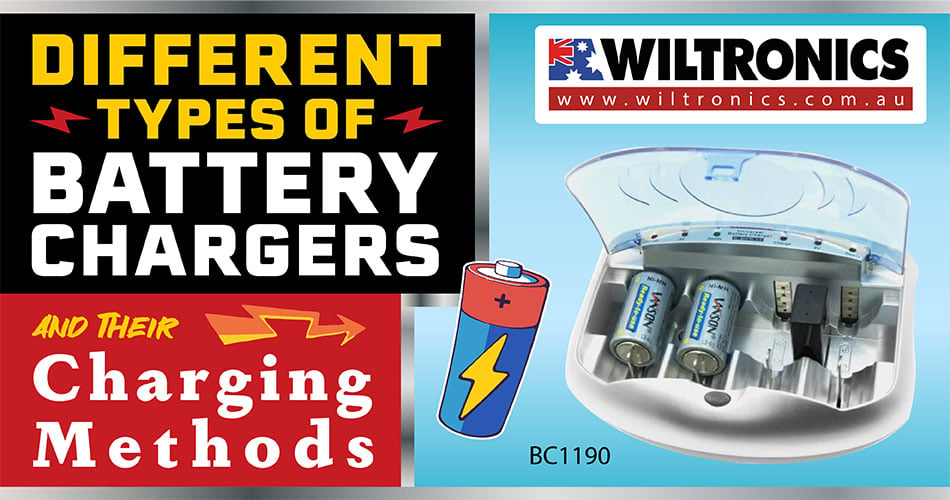
Power to-go, please! Are batteries not brilliant? Unfortunately, they only store a certain amount of electric charge before going flat. But the case is different for rechargeable ones. They have a complementary device that keeps them going. All thanks to the various types of battery chargers!
Batteries
In our previous post, we discussed the advancement of today’s best batteries. Generally, batteries are electrical storage devices that generate electricity. Through this chemical reaction, they can store and provide energy to power devices.
Those that are ‘disposable’ are called primary batteries. In simple terms, they are single-use solutions and not reversible. And those that can be used multiple times are secondary batteries. In short, they are rechargeable. But modern productions feature cost-efficiency with longer lifespans, be it primary or secondary.
Regardless of the type, all have one thing in common: they are constantly used for everyday devices.
Battery Chargers
If you use secondary-type batteries, you can rely on battery chargers. Click the cells in the charging device, plug it in, and they will be good as new in a few hours – and ready to use again.
A battery charger is designed to provide a safe, consistent charge to batteries. The structure consists of three main components:
- Power supply. This part includes an AC/DC adapter or connection cable to take energy from the wall outlet.
- Charging circuit. Takes the energy and converts it into a sustainable voltage for the battery.
- Control circuitry. Regulates the charger’s output to optimise charging speed. At the same time, it protects the charger and battery from overcharging or short-circuiting.
Different types of chargers have different voltages and currents designed for specific batteries.
Other components that make up all types of battery chargers include: 1.) AC transformer or rectifier, 2.) output power transistor, which regulates current limiting and over/under voltage protection, 3.) indicator LED or display, which showing status and fault conditions, 4.) internal safety circuits and fuses/circuit breakers, 5.) microprocessor and timers, which control cycle rate and runtime.
Battery chargers also come with built-in safety features to prevent overcharging. Some models have multiple settings for charging various kinds of batteries at once. And there are different types of battery chargers, too. Depending on the variety, it can plug into a wall socket, a car cigarette lighter, or USB ports.
How do battery chargers work?
Battery chargers are an indispensable tool when it comes to powering your devices. But how do battery chargers actually work?
At the most basic, all types of battery chargers work by providing electrical current. This current flows from the power outlet or other source into a device’s battery. When plugged in, the charger creates a closed circuit allowing electricity to flow.
The charger itself determines the voltage of this current. It usually corresponds to the specifications of the battery it will charge.
Charging methods: fast and slow
There are two different ways to charge a battery: fast and slow. Fast charging essentially means using a higher charging current for a shorter time. Meanwhile, slow charging uses a lower current for longer.
There are several common methods of charging, such as pulse charging. Pulse charging involves sending intermittent pulses of high current through the battery. It can also be useful for reviving older, degraded batteries, e.g. lead-acid.
Charging time
The ideal charging time varies depending on the following few reasons:
- How much charge does the battery hold?
- How hot and old is it?
- Is one cell performing better than others?
Now, how does a charger know when to stop? Different methods are used for various types of batteries and a slow charge or fast charge.
The best chargers work ‘smart’, using microchip-based electronic circuits. To determine how much charge is stored in the batteries, you may see changes in the battery voltage. Technically, this is called delta V or ΔV. The other is the cell temperature or delta T or ΔT.
When the charging is done, the charger switches off the current. Or it changes to a low trickle charge at the appropriate time.
Different Types of Battery Chargers
As technology has advanced, so too have the various types of battery chargers. Here is a look at some of the different types of battery chargers on the market today:
Manual battery chargers
This type of battery charger charges the battery they are attached to. It does not cycle or shut down by itself. Instead, it will push current at the selected setting until you disconnect it.
When using one, keep an eye on the ammeter to see whether a full charge is achieved. Or use a hydrometer or voltmeter to determine the charge level. Stop the charging process as soon as the battery is full to prevent battery damage.
Automatic battery chargers
Unlike manuals, automatic battery chargers will stop charging once fully charged. It will then switch to a Maintain Mode or float mode. The automatic types also do not impact battery life or safety. Yet, they should not stay connected for long periods or as maintenance chargers.
Solar battery chargers
Solar-powered battery chargers are just what they sound like. They use solar energy to power their operations instead of direct current electricity. They are becoming ever more popular due in part to their portability and ease of use. Their efficiency also plays a major part.
Read this beginner guide to solar panels to learn more about how solar devices, in general, work.
Trickle chargers
A trickle charger allows for a battery to be left attached for a day or two, once a month. Unlike float chargers, they have no sensor to determine when or if a battery is charged. They will continue to deliver current until disconnected like manual chargers.
To use, connect it like you would any other battery charger. The ideal charging time is once per month for no longer than a day or two.
Types of Battery Charger Technology
Most modern battery chargers use either constant voltage or switch-mode charging technology. Constant voltage charging applies a predetermined voltage across the terminals of the battery. All that while restricting current flow using an internal resistance at a set level.
Switch mode charging, meanwhile, uses a Pulse Width Modulation (PWM) technique. This applies varying voltages under varying levels of load and acceleration control. This also depends on specific conditions, such as temperature and the charge state of the cell(s).
Get Your Battery Chargers Here!
Wiltronics offers various types of battery chargers for charging AA, AAA, C, D, and 9V Ni-CAD/ NIMH. Check them out below:
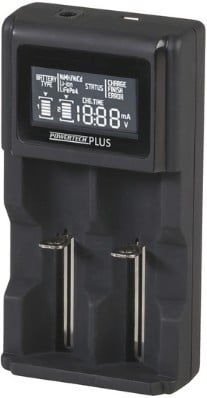
Battery Charger – LiFePO4, Li-ion, Ni-MH, Ni-Cd
Product code: JMB3635
4.2V charging mode for lithium-ion batteries and 1.48V for nickel-ion batteries. Charges and monitors both charging lanes independently for the best battery conditioning. LCD provides feedback on current, charge time and battery voltage.
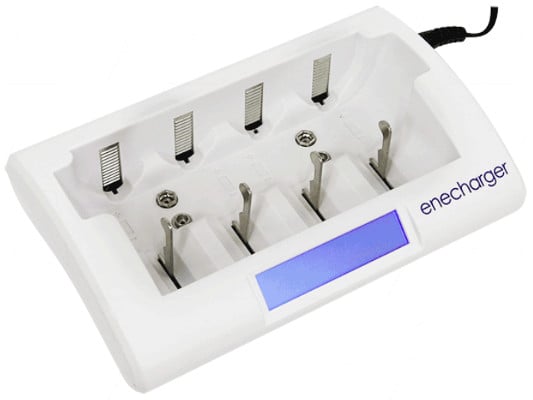
Enecharger Battery Charger 4x AA/AAA/C/D
Product code: BC1188
With this battery charger, you can charge 1-4 AAA/AA/C/D size NiMH and/or 1-2 9v size NiMH at the same time.
Individual charging channels are microprocessor controlled with a negative delta V cut-off function. The charging status is also displayed on the backlit LED screen:
- CHARGE: battery charging in process
- FULL: battery charging complete
- BAD: faulty/non-rechargeable cells detected
Auto safety shut-off and overcharge protection help maximise battery life. A built-in, fold-out plug design also lets you easily store the Pro Charger Battery Charger when not in use.
Compatible with all AAA and AA NiMH rechargeable batteries.
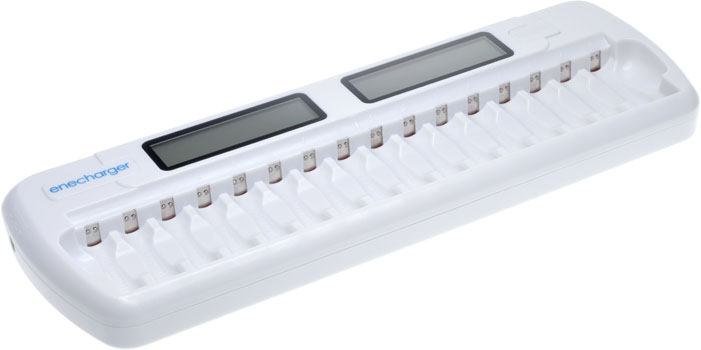
Fast Battery Charger AA/AAA
Product code: BC1203
This fast battery charger AA/AAA can charge up to 16 AA or AAA batteries simultaneously. It also works with either NiMH or NiCd batteries. Ideal for charging large amounts of batteries quickly, and you can charge a mix of AA and AAA batteries at once!
Other features include two blue backlit LCDs. These show the charge status for each independent charging bay.
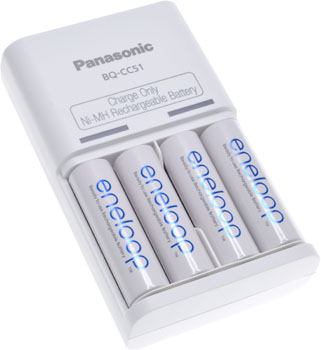
Panasonic AA/AAA Charger With 4 Eneloop AA Batteries
Product code: BC1904
Comes with 4 Eneloop pre-charged 2100mAh batteries. Specifications include:
- Input: AC 100–240 V / 50–60 Hz 0.2 A
- Output: DC 3.0 V — 200 mA x 2 (AA size) DC 3.0 V — 80 mA x 2 (AAA size)
- Operating Temperature: 0~40°C (Indoor use only)
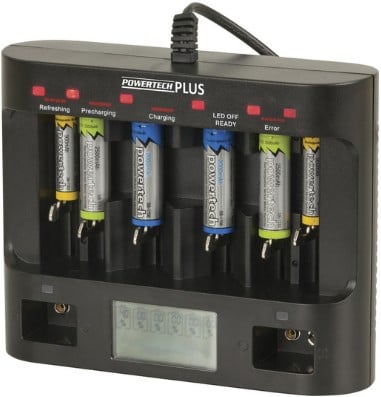
Universal Fast NIMH Charger AA/C/D 9V with LCD & USB Outlet
Product code: BC1185
Recharge up to 6 at a time, with two exclusive slots for 9V rechargeable batteries. With up to 1A charging per cell (depending on size), AA cells can charge in a matter of hours. An LCD panel and status lights provide info on the charging status.
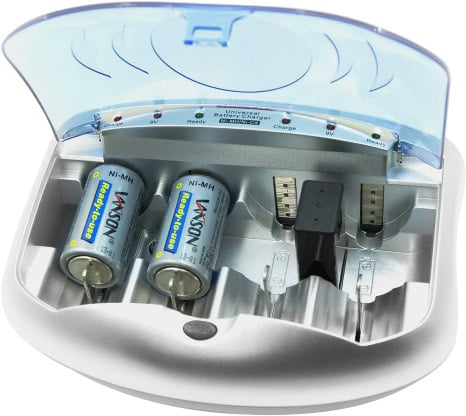
Vanson AA, AAA, C, D, & 9V Universal Ni-MH Charger
Product code: BC1190
Supplied with chargers for 240VAC operation or a 12VDC lead for car charging. Features Delta V charging, automatic timer, bad cell detection and LED.
The Bottom Line
Battery chargers have several different varieties which use a variety of charging methods. The most common type of charger is automatic. Other types of battery chargers include solar-powered and trickle chargers. All ensure efficient and safe means for maintaining a charged battery.
© Electrotech Brands Pty Ltd 2023


Write a Comment
You must be logged in to post a comment.